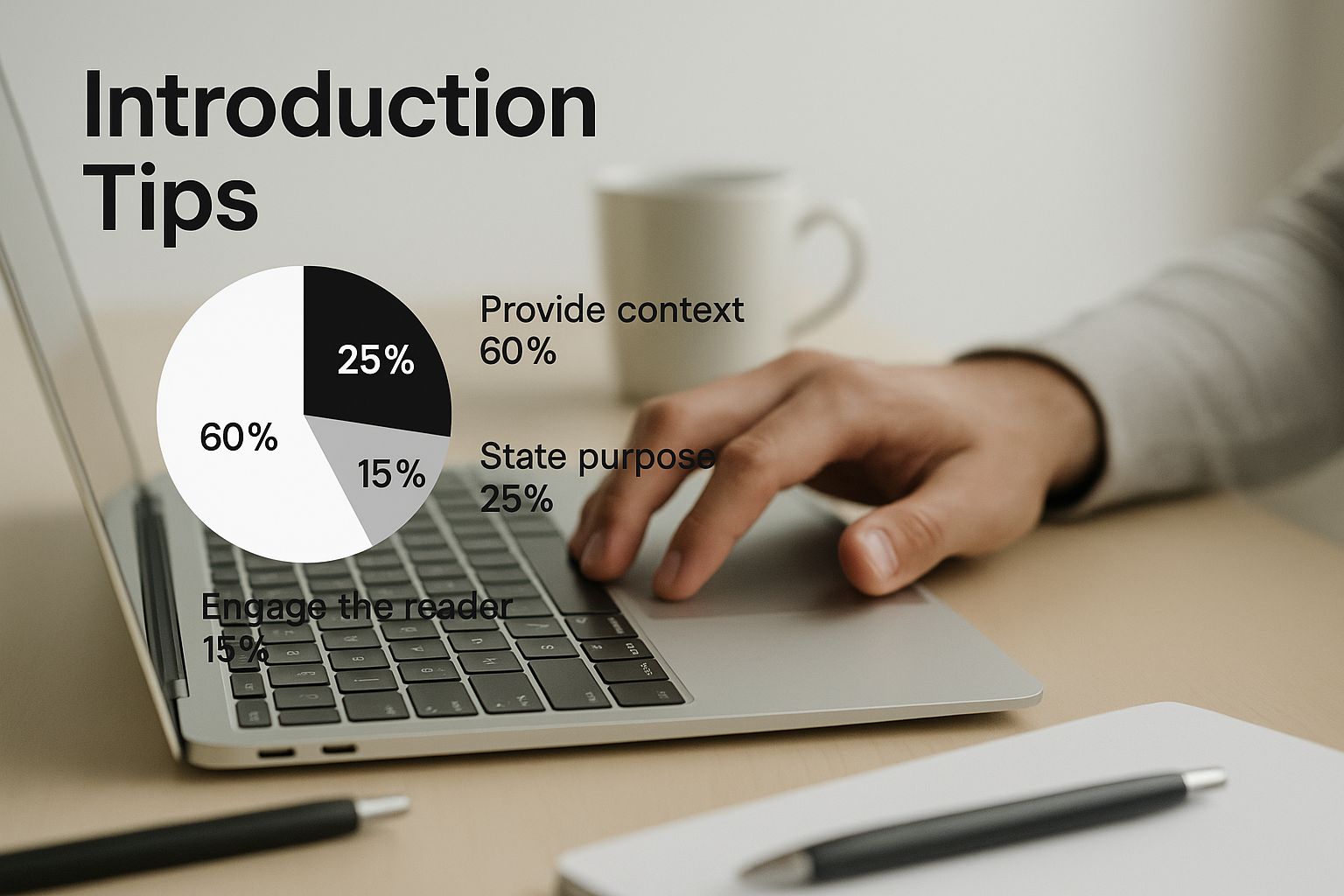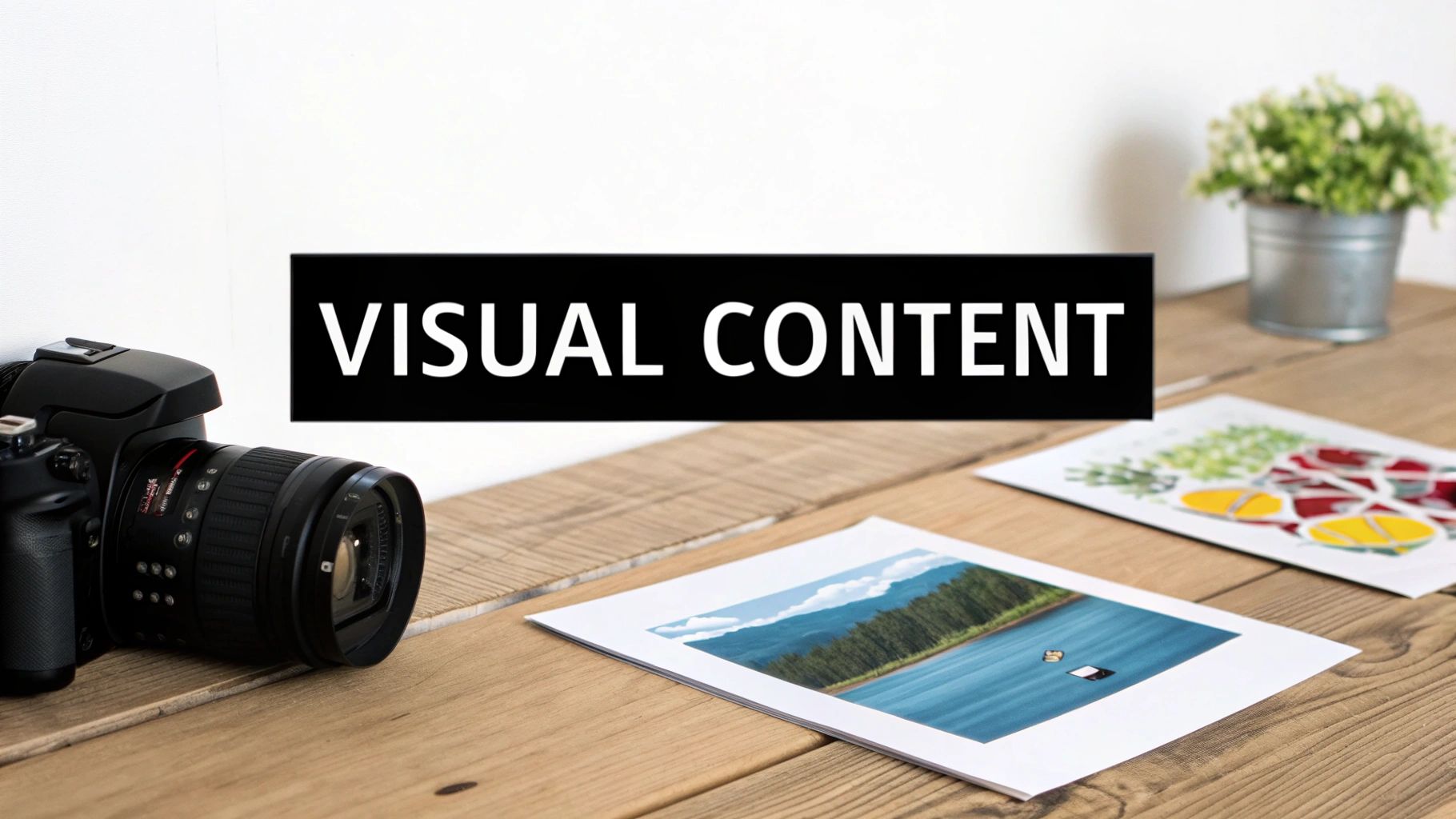
Master the Blog Post Format to Boost Engagement
Published on 2025-05-06
The Evolution of Blog Post Formats: From Text to Experience
Blog posts have evolved significantly from their humble beginnings as simple online journals. The initial blog post format was basic: primarily plain text, occasionally accompanied by a few images. This simplicity reflected the technological limitations of the early internet. However, as technology progressed, so did the potential for deeper reader engagement. This evolution has fundamentally changed how we consume and interact with online content.
This shift towards richer, more engaging content was fueled by several key advancements. The advent of multimedia allowed bloggers to incorporate images, videos, and audio into their posts. This transformed the static, text-based format into a dynamic, multi-sensory experience. The rise of social media also played a crucial role, emphasizing shareability and visual appeal.
These platforms promoted concise content and captivating visuals, influencing the design and structure of blog posts.
The emergence of microblogging between 2006 and 2007 introduced extremely short blog formats, epitomized by Twitter's initial 140-character limit. Jack Dorsey’s first tweet ("just setting up my twttr") in March 2006 marked this shift. By 2013, Twitter averaged 500 million tweets per day, demonstrating the global embrace of bite-sized content. Tumblr, launched in February 2007, became a popular platform for multimedia microblogs, reaching 300 million monthly users by 2014. This period popularized minimalist formats, with 40% of bloggers subsequently adopting short-form posts to supplement their long-form content. Explore this topic further here.
From Static Text to Dynamic Content
Early blogs primarily consisted of written content, resembling digital journal entries. This began to change as internet speeds increased and technology enabled richer media integration. The ability to seamlessly embed images and videos directly within a post created new opportunities for storytelling and engagement. Bloggers could now show, not just tell, enhancing the reader's experience. This also affected the overall blog post format, with a greater focus on visual hierarchy and the interplay between text and visuals.
The Impact of Social Media
The proliferation of social media platforms like Facebook and Instagram has significantly influenced blog post format. These platforms prioritized shareability and visual appeal, leading to shorter, more concise blog posts, often accompanied by captivating images and videos optimized for social sharing. The emphasis on real-time interaction also encouraged bloggers to incorporate features like social sharing buttons and comment sections directly into their posts. This integration blurred the lines between blog posts and social media updates, resulting in a more interactive and dynamic online experience.
The Mobile-First Era
The widespread use of smartphones and tablets has further molded blog post format. With increasing numbers of people accessing content on mobile devices, bloggers needed to adapt to smaller screens and different user behaviors. This led to the adoption of responsive design, ensuring blog posts displayed correctly on any device. Mobile users often prefer easily scannable content, prompting bloggers to use clear headings, bullet points, and concise paragraphs for better readability. These adaptations have made blog posts more accessible and engaging for a broader audience, irrespective of the device they are using.
Anatomy of High-Converting Blog Post Formats
What separates a truly captivating blog post from one that fades into oblivion? Often, the secret lies in its format. An effective blog post isn't just about presenting information; it's about creating an engaging experience that's easy to navigate and encourages interaction. This involves careful consideration of every element, from the headline to the call to action.
The Power of Headlines and Introductions
A compelling headline is the first impression. It's the digital handshake that draws readers in. Research indicates that strategically crafted headlines can boost click-through rates by up to 73%. Using numbers, questions, or strong adjectives can significantly increase reader interest. For instance, "5 Proven Strategies to Boost Your Blog Traffic" is far more compelling than a generic title like "Tips for Increasing Blog Traffic."
A strong introduction is equally important for minimizing bounce rates. It's the hook that keeps readers engaged and sets the stage for the rest of the post. Starting with a thought-provoking question, a surprising statistic, or a relatable anecdote can pique reader curiosity and encourage them to delve deeper into the content.
Structuring Content for Readability
Subheadings provide structure and clarity, breaking down large chunks of text into digestible sections. This not only enhances readability but also allows readers to quickly scan and locate the information most relevant to them. Subheadings act as a roadmap, guiding readers through the content.
Paragraph length also plays a crucial role. Shorter paragraphs, typically 2-4 sentences, are easier to process and maintain reader attention, especially on mobile devices. Longer paragraphs can feel daunting and may lead to reader disengagement.
Visual Engagement and Calls to Action
Visuals, such as images and infographics, enrich the blog post format and improve comprehension. Infographics can be particularly effective for presenting complex data in a visually appealing and easily digestible manner. The following data chart illustrates the relative impact of various blog post elements on reader engagement and SEO:

This chart shows the varying impacts of different elements on reader engagement. While all elements contribute, compelling headlines and strong visuals appear to have the most significant effect, along with the skimmability of the content, highlighting the importance of clear structure.
To understand the effectiveness of different blog post elements further, let's examine the following table:
Key Blog Post Format Elements by Reader Impact
| Element | Reader Impact | SEO Impact | Implementation Difficulty |
|---|---|---|---|
| Compelling Headlines | High | High | Medium |
| Strong Introduction | High | Medium | Medium |
| Subheadings | Medium | High | Low |
| Short Paragraphs | Medium | Medium | Low |
| Visuals (Images, Infographics) | High | Medium | Medium |
| Calls to Action | High | Medium | Low |
This table summarizes the relative impact of each element on both reader engagement and SEO performance, as well as the relative difficulty of implementing each element. As you can see, some elements offer high impact with relatively low implementation difficulty.
Finally, strategically placed calls to action (CTAs) are essential for converting passive readers into active participants. A clear and concise CTA at the end of each post prompts readers to take the next step, whether it's subscribing to a newsletter, downloading a resource, or leaving a comment. Highlighting CTAs with buttons or distinct visual styling can significantly improve conversion rates.
Visual Elements That Transform Blog Post Performance
Visuals are essential for successful blog posts. They aren't just decoration; they're powerful tools that significantly impact how readers interact with your content. In our information-saturated world, visuals can make your blog stand out.
The Impact of Visuals on Engagement
Top blogs use visuals to enhance their message and captivate their audience. Studies reveal that relevant visuals increase time-on-page by an average of 57%. Visuals break up text, making content more digestible and appealing. A well-placed image provides a visual break, allowing readers to process information.
Visuals also boost information retention and sharing. Visual content is processed 60,000 times faster than text, enabling readers to grasp complex ideas quickly. This leads to higher engagement and more sharing.
For tips on creating engaging content, see our article on blog post formatting.
Selecting and Positioning Visuals Strategically
Visual effectiveness depends on careful selection and placement. Images should be high-quality, relevant, and strategically positioned to enhance content flow. Overusing images can create visual clutter and distract from your message.
Consider image size and formatting. Large images can slow page load times, impacting user experience. Optimizing images for web use is crucial. Compress images without sacrificing quality, ensuring they load quickly on any device.
Video: A Dynamic Addition to Your Blog Post Format
Video blogging has transformed online content consumption. After YouTube's 2005 launch, video blogging (vlogging) became mainstream. By 2007, YouTube hosted over 200,000 vlogs daily. Cisco's 2023 data shows video accounts for 82% of global internet traffic, and blogs increasingly embed videos for better engagement. Learn more about the evolution of blogs. This highlights video's growing importance and its potential to boost blog engagement.

Maintaining Brand Consistency
Visual distinctiveness is important, but so is brand consistency. A consistent color palette, typography, and image style reinforce brand identity and create a cohesive online presence. This builds recognition and trust, making your blog more memorable.
Visual elements transform blog posts from simple text into engaging experiences. By strategically selecting, sizing, and positioning visuals, you enhance your blog's performance and create resonant content. This involves understanding visual impact, choosing the right formats, and maintaining brand consistency.
Building Blog Post Formats That Search Engines Love
Search visibility isn't just about keywords; it's about structure. Analyzing top-performing content reveals how successful bloggers format their posts to rank higher. Understanding these formatting patterns is key to attracting both search engines and human readers.
Heading Structures and Crawlability
Search engines use headings (H2, H3, etc.) to understand your content. Think of headings as signposts that guide search engine crawlers through your blog post format. A clear hierarchy improves crawlability, allowing search engines to easily index and understand your content’s key themes. This, in turn, helps your post rank for relevant keywords.
Formatting Patterns for Higher Rankings
Certain formatting patterns correlate with higher search rankings. For example, using numbered lists and bullet points makes content easily scannable for both readers and search engines. This also helps improve content readability, as seen in some Wix blog posts. This structured blog post format can enhance user experience and signal to search engines that your content is well-organized and helpful. Additionally, using short paragraphs, typically 2-4 sentences, improves readability and keeps readers engaged.
This means that a well-formatted blog post isn’t just visually appealing; it’s structurally sound for search engines. Speaking of structure, the evolution of blogging tools has significantly changed how we format content. AI-powered blogging tools like ChatGPT, which emerged in 2022, have changed content formatting. A 2023 HubSpot study revealed that 35% of bloggers use AI for drafting, and 15% automate entire posts. These tools generate SEO-optimized structures (H2/H3 headers, keyword placement) and suggest data visualization formats.
This shift aligned with Google’s 2022 algorithm update prioritizing ‘helpful content’ with clear formatting. This update subsequently led to a 20% increase in listicles and how-to guides among top-ranking posts. Learn more about the history of blogging.
To better illustrate which blog post formats perform best in various industries, let's take a look at the table below:
Popular Blog Post Format Types by Industry This table presents data on which blog post formats perform best across different industries based on engagement metrics.
| Industry | Top Format #1 | Top Format #2 | Average Engagement Rate |
|---|---|---|---|
| Technology | Listicles | How-to Guides | 6% |
| Marketing | Case Studies | News Articles | 4% |
| Healthcare | Infographics | Expert Interviews | 3% |
| Finance | Data-Driven Articles | Opinion Pieces | 2% |
As the table shows, listicles and how-to guides see the highest engagement in the tech industry, while case studies are favored in marketing. Understanding these trends can inform your content strategy.
Keyword Placement and Readability
While keywords are important, their placement shouldn’t compromise readability. Integrate your target keyword, "blog post format," naturally within the content. For example, instead of awkwardly stuffing the keyword into every sentence, focus on using related phrases and synonyms. This creates a better reading experience and helps search engines understand the context of your content. For further insights on crafting engaging content, you might be interested in learning how to master LinkedIn posts.
Balancing SEO and User Experience
The key is to find a balance between SEO optimization and readability. While clear headings and structured formatting help search engines, they also make your content more accessible and engaging for readers. By focusing on creating a positive user experience, you naturally create content that search engines love. This approach benefits both your readers and your search ranking.
Ready-to-Use Blog Post Format Templates That Convert
Stop reinventing the wheel with every blog post. We've analyzed countless high-performing blog posts and identified format patterns that consistently outperform the competition. This section offers adaptable templates for five of the most successful blog post formats: comprehensive guides, data-driven listicles, case study narratives, comparison frameworks, and thought leadership pieces. Each template provides specific guidance on structuring sections, distributing content, and strategically placing elements to maximize reader engagement. Learn how to tailor these proven structures to your unique voice and topic while maintaining the crucial formatting elements that drive results, based on real performance data.

Comprehensive Guides
This blog post format is perfect for deep dives into a specific subject. Think of it as the ultimate resource on a chosen topic. Structure it with clear headings (H2s and H3s) and include a table of contents for easy navigation. A comprehensive guide on “choosing the right bicycle,” for example, could cover everything from frame materials to gear systems.
- Key Elements: Table of contents, detailed explanations, practical examples, relevant visuals, and internal links to other related content.
- Benefits: Positions you as an expert, improves organic traffic, and delivers substantial value to your readers.
Data-Driven Listicles
Listicles are naturally engaging because they are easy to digest. Data-driven listicles add a layer of credibility by supporting each point with statistics and facts. This makes the content more persuasive and shareable on platforms like Twitter. Their skimmable format makes them ideal for today's busy readers.
- Key Elements: Numbered list, supporting data points, concise explanations, and impactful visuals.
- Benefits: High shareability, broader audience reach, and effective communication of complex information.
Case Study Narratives
Case studies are a powerful way to demonstrate the value of your product or service. They present real-world examples of success and build trust with potential customers by showcasing tangible results. Storytelling is central to this format, making it more relatable and memorable.
- Key Elements: Clear problem statement, solution implemented, quantifiable results achieved, client testimonial, and a compelling call to action.
- Benefits: Builds credibility, demonstrates real-world impact, and can effectively drive conversions.
Comparison Frameworks
Comparison posts help readers make informed decisions by presenting a side-by-side analysis of different options. This format is particularly helpful for product reviews or comparisons of competing services. Using tables for clear data presentation is highly recommended.
- Key Elements: Well-defined comparison criteria, objective analysis, clear pros and cons, and a concise summary of key differences.
- Benefits: Empowers readers to make smart decisions, attracts targeted traffic, and establishes you as a trustworthy, unbiased resource. You might be interested in: How to master content repurposing.
Thought Leadership Pieces
Thought leadership content allows you to share your unique insights and build your reputation as an authority in your field. These posts often address current industry trends or propose fresh solutions to existing challenges. They provide valuable perspectives and stimulate discussion.
- Key Elements: Original insights, clearly articulated opinions, supporting evidence, and a strong takeaway message.
- Benefits: Builds brand authority, generates discussion, and cultivates a loyal following. Ensuring your blog posts are visible to search engines is crucial. Learn about optimizing content for SEO.
By understanding and applying these ready-to-use templates, you can craft blog posts that connect with your audience and achieve tangible results. Remember to adapt the blog post format to best suit your content and always prioritize readability.
Mobile-First Blog Post Formatting Strategies
With over 55% of content consumed on mobile devices, optimizing your blog post format for smaller screens is crucial for reader engagement. This goes beyond simply shrinking desktop layouts. Leading content creators are actively adapting their strategies to create exceptional mobile experiences.
Touch-Friendly Spacing and Scannable Content
Mobile users are often on the move and need easily digestible content. Short paragraphs, typically 2-4 sentences, are essential for readability. Generous spacing between elements also improves the mobile experience. Think of it like designing a comfortable room: enough space makes it easier to navigate and enjoy. This touch-friendly approach prevents accidental clicks and improves the overall flow.
Bullet points and numbered lists further enhance scannability, allowing readers to quickly grasp key information. These formatting choices directly impact bounce rates. Cluttered layouts often lead to quick exits.
Responsive Visuals and Optimized Images
Visuals boost engagement, but can hinder mobile performance if not optimized. Images should be responsive, scaling to different screen sizes. Large image files can slow loading speeds, impacting user experience and SEO. Compressing images without sacrificing quality is critical for mobile optimization. This ensures visuals enhance, not detract from, the user experience. For help with social media and content creation, see: How to Master Social Media Content Planning.
Adapting Desktop Formats for Mobile Engagement
Successful blogs don't just replicate their desktop blog post format on mobile. They strategically adapt it. Long-form content, for example, can be broken into shorter, mobile-friendly installments. Interactive elements, like quizzes or polls, can also increase mobile engagement.
Furthermore, calls to action should be prominent and easy to tap on a touchscreen. This might involve larger buttons or simplified forms. These adaptations acknowledge the unique aspects of mobile consumption, creating a tailored experience.
Testing and Data-Driven Improvements
Mobile optimization is an ongoing process. Regularly test your blog post format on various devices to find potential problems. Use analytics to track metrics like bounce rate, time on page, and scroll depth. This data offers valuable insights into how users interact with your mobile content.
For example, a high bounce rate might suggest formatting problems. A/B testing different formats provides evidence of what resonates best with your audience. This data-driven approach allows for continuous improvement, ensuring your mobile blog post format consistently provides a positive experience.
Measuring What Matters: Blog Post Format Analytics
Beyond simple pageviews, what truly makes a blog post format successful? Data-driven content teams use a specific set of measurements to continually improve their approach. Let's explore how these teams use analytics to understand reader behavior on a deeper level.
Beyond Pageviews: Deeper Dive into Engagement
Pageviews provide a basic understanding of reach, but they don't tell the whole story. Heat mapping, using tools like Hotjar, visually shows where users click and scroll. This reveals which elements of your blog post format are grabbing attention, and which are being overlooked. Understanding this helps optimize the placement of calls to action, images, and other key components for maximum impact.
Scroll depth analysis, often provided by analytics platforms like Google Analytics, tracks how far down the page readers scroll. This helps determine if your content is holding their attention. Low scroll depth may indicate a blog post format that isn't captivating readers. Conversely, high scroll depth often signals strong engagement and helps inform decisions about content length.
Segment-Based Engagement Metrics
Analyzing engagement by segment provides even richer insights. This means examining metrics like click-through rate and time on page for different reader groups. These groups could be based on demographics, traffic sources, or device type. For instance, your blog post format might resonate with desktop users, but underperform on mobile. Segment-based analysis helps pinpoint these format weaknesses that might be invisible in standard analytics reports. This detailed information empowers you to make targeted format improvements.
A/B Testing for Continuous Improvement
Leading content teams utilize A/B testing to systematically refine their blog post format. This method involves creating two versions of a blog post with slight format variations, like headline, image placement, or call-to-action wording. Each version is then presented to different reader groups. By analyzing metrics such as conversions and engagement, teams identify which version performs better. This approach moves beyond assumptions and allows optimization based on actual user behavior.
By implementing these measurement strategies, you create a continuous improvement cycle, ensuring your blog post format remains effective and engaging for your readers, even as their preferences evolve. This adaptable approach is key for long-term content success.